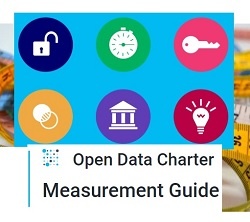Open Data Charter Measurement Guide (May 2018)
28/05/2018

Do you work with #opendata? Then take a look at the @opendatacharter Measurement Guide. 
Open Data Charter Measurement Guide - a collaborative effort of the Charter’s Measurement and Accountability Working Group - analyses the Open Data Charter principles and how they are assessed based on current open government data measurement tools. Governments, civil society, journalists, and researchers may use it to better understand how they can measure open data activities according to the Charter principles.
|
Open Data Charter Principles
Consult Open Data Charter GitBook |
The Measurement Guide seeks to...
shed light on the often opaque and jargon-filled world of open data measurement, and provides an analysis of the indicators, which includes comprehensive tables of global indicators (e.g. indicator tables) per each Charter principle.
The Measurement Guide is not a new measurement tool by which Charter adopters will be marked on their progress. Instead, its purpose is to:
-
Help governments inform, design, implement, monitor and re-engineer their open data activities, including data publication policies and improvement programs.
-
Understand and engage with the underlying analytical framework and architecture of existing indicators.
Within this framework, the Measurement Guide will support:
-
- Governments : - during the Charter implementation process, to help them measure their progress in designing programmes that deliver their commitments and better formulate Charter adoption statements, including national and sub-national plans,
-
- Civil society and communicators : - to monitor progress of government open data policies/action plans and develop recommendations for improvement,
-
- Researchers and open data assessment practitioners : - to identify measurement gaps, improve current indicators, and develop new ones,
-
- Funders/donors : - to better understand existing measurement tools and improvements that they could potentially support in the future.
WHAT CAN I FIND IN THE MEASUREMENT GUIDE?1. An executive summary for people who want to quickly understand what measurement tools exist and for what principles,
2. An analysis of how each Charter principle is measured, including a comparison of indicators that are currently used to measure each Charter principle and its commitments.
-
The Measurement Guide provides insights from open data experts and members of organizations who work on open data measurement tools. Analysis of the coverage of the five leading open data measurement tools:
- Open Data Barometer (ODB),
- Global Open Data Index (GODI): tracking the state of open governmental data,
- Open Data Inventory (ODIN),
- Open Useful Reusable Government Data (OURdata),
- European Open Data Maturity Assessment (EODMA),
– reveals that only parts of Charter principle commitments, and their components, are being measured; or that some commitments could be measured in the future. However, some Charter concepts are either too broad (e.g. “high-quality data”, “usability by the widest range of users”), or lack a shared interpretation, which makes them difficult to find a common indicator.Read on more in Five open data measurement tools.
3. Comprehensive indicator tables show how each Charter principle commitment can be measured. This table is especially helpful when used to compare how different indices approach the same commitment, and where gaps exist. Here, you can see an example of the indicator tables for Principle 1.
4. A methodology section that details how the Working Group conducted the analysis of mapping existing measurements indices against Charter commitments.
5. A recommended list of resources for anyone who wants to read more about measurement and policy.
The Measurement Guide is available online in the form of a Gitbook and in a printable PDF version. If you are interested in using the indicators to measure open data, visit these indicator tables for each principle, or find the guide’s raw data here.
Do you have comments or questions? Share your feedback with the community using the hashtag #OpenDataImpact, #OpenDataMetrics or get in touch with Measurement and Accountability Working Group at [email protected].
Related:

